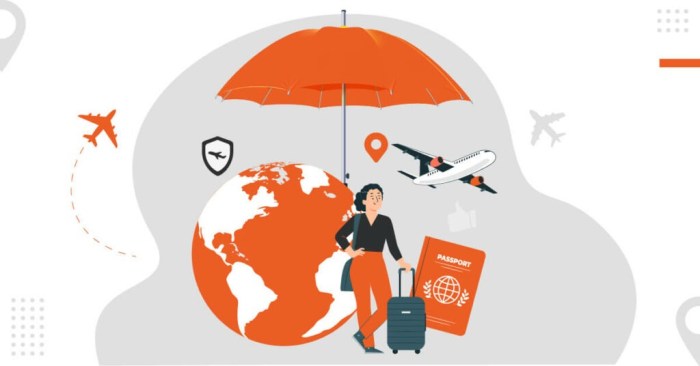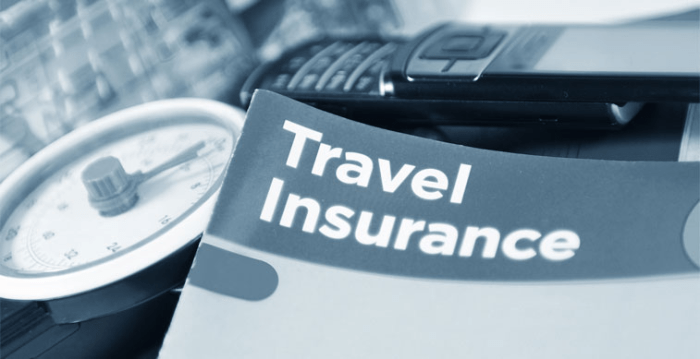Best Business Travel Insurance Your Comprehensive Guide
Best business travel insurance is crucial for safeguarding your ventures and personnel. This guide delves into the intricacies of protecting your business and employees during international trips. From defining the essentials of business travel insurance to comparing various providers, we’ll explore all aspects of ensuring smooth and secure journeys for your teams.
We’ll examine the key elements of a comprehensive business travel policy, highlighting the importance of coverage for medical emergencies, trip disruptions, and lost belongings. Understanding the factors influencing insurance costs and how to compare providers will also be addressed. We’ll equip you with the knowledge to select the ideal policy to suit your business’s unique needs and safeguard your investments.
Defining Business Travel Insurance
Business travel insurance is a specialized form of travel insurance designed specifically for individuals traveling on business. Unlike personal travel insurance, it caters to the unique needs and risks associated with professional trips, offering a comprehensive safety net for both the traveler and the company. It’s a crucial investment for businesses and employees alike, providing financial protection against unforeseen events that can disrupt a business trip and negatively impact productivity.
This comprehensive insurance goes beyond the typical coverage found in personal travel plans, often encompassing aspects like trip cancellations due to unforeseen circumstances, medical emergencies abroad, lost or damaged business-related items, and liability protection. By understanding the distinct characteristics of business travel insurance, you can make well-informed decisions about securing the appropriate coverage for your upcoming trips.
Key Features and Benefits
Business travel insurance extends beyond basic travel protection, providing a robust safety net against a range of potential issues. It’s a critical investment for safeguarding both the traveler and the company’s interests. Key benefits often include: comprehensive medical coverage abroad, reimbursement for trip cancellations due to unforeseen events, and protection against lost or damaged business-related items. This protection is particularly important in cases where business trips involve significant investments in equipment or samples.
Types of Business Travel Insurance
Various types of coverage are included in a business travel insurance policy, each addressing specific risks.
- Trip Cancellation Insurance: This component of business travel insurance safeguards against unforeseen events that necessitate the cancellation of a business trip. It often covers cancellations due to illness, severe weather, or other unforeseen circumstances. This type of coverage is crucial for minimizing financial losses and operational disruptions resulting from trip cancellations. For example, a sudden illness that prevents a crucial sales presentation or a critical meeting could be financially devastating without this coverage.
- Medical Insurance: This critical aspect provides coverage for medical expenses incurred during a business trip abroad. It ensures that medical emergencies are handled effectively, minimizing financial burdens and ensuring access to quality care. A medical emergency in a foreign country can lead to substantial medical costs if not protected by adequate insurance.
- Baggage Insurance: This coverage protects against the loss or damage of business-related items, such as equipment, samples, or important documents. This coverage is essential for maintaining business continuity, particularly for professionals carrying sensitive materials or expensive equipment on business trips.
- Liability Insurance: Some business travel insurance policies include liability coverage, protecting the traveler from potential legal liabilities arising during a business trip. This is especially important for individuals representing their company or conducting business activities that may carry legal implications.
Comparison of Coverage Types
The table below provides a concise comparison of the different types of business travel insurance coverage, highlighting their key features and benefits:
| Coverage Type | Description | Typical Benefits |
|---|---|---|
| Trip Cancellation | Covers the costs associated with trip cancellations due to unforeseen circumstances. | Reimbursement of non-refundable trip expenses (flights, accommodation, etc.), potentially covering costs for alternative arrangements or rescheduling. |
| Medical | Provides coverage for medical expenses incurred during a business trip abroad. | Reimbursement of medical bills, emergency transportation, and other related costs. Often includes coverage for pre-existing conditions, depending on the policy. |
| Baggage | Protects against the loss or damage of business-related items during travel. | Reimbursement for lost or damaged equipment, samples, documents, or other essential items. |
| Liability | Protects the traveler from potential legal liabilities during a business trip. | Covers legal costs and potential settlements related to accidents or other incidents. |
Essential Coverage Elements
Business travel insurance is crucial for protecting your financial well-being and peace of mind when you’re away on business trips. Proper coverage safeguards against unforeseen circumstances, ensuring your trip proceeds smoothly and you’re adequately supported if something goes wrong. This section highlights essential elements for a robust policy.
Medical Evacuation and Repatriation
Medical emergencies can occur unexpectedly, regardless of destination. Medical evacuation coverage is vital, especially for international travel. This often includes transportation to a suitable medical facility, potentially overseas. Repatriation coverage, a related aspect, covers the cost of transporting the insured person back home, should medical intervention or other serious circumstances necessitate it. This aspect of insurance is paramount, as medical costs and logistical challenges abroad can be substantial. Examples include the cost of air ambulance transport to a specialized facility, or the expenses for returning home in a medical emergency.
Trip Interruption and Cancellation Protection
Unforeseen circumstances can disrupt or cancel business trips. Trip interruption protection steps in to cover expenses should a trip be cut short due to unforeseen events like a sudden illness or a natural disaster. Cancellation protection, conversely, covers pre-trip expenses if the trip must be cancelled due to an unforeseen reason, such as a sudden and severe illness or a family emergency. This coverage is valuable, particularly for business trips with tight schedules and critical appointments. For instance, if a flight is cancelled due to a storm, trip interruption protection would cover any necessary hotel stays or alternative transportation arrangements. Cancellation protection could cover pre-paid hotel rooms, travel tickets, and other trip-related expenses.
Baggage and Personal Liability Coverage
Baggage protection is essential for covering lost, damaged, or stolen belongings during your trip. This often includes coverage for personal items, essential documents, and professional equipment. Personal liability coverage is equally important, safeguarding you against potential legal liabilities arising from incidents involving others, such as accidents. The value of this coverage is underscored by the fact that a single incident can result in considerable financial implications.
Common Exclusions in Business Travel Insurance Policies
Insurance policies typically contain exclusions to limit coverage for certain situations. Understanding these exclusions is essential for making informed decisions.
| Exclusion | Description |
|---|---|
| Pre-existing conditions | Conditions diagnosed or treated before the policy’s effective date, often with limited or no coverage, especially if not declared. |
| War or acts of terrorism | Events related to armed conflicts or acts of terrorism are generally excluded, as these events are often unpredictable and beyond the control of the insurer. |
| Intentional self-harm | Injuries or illnesses resulting from deliberate self-harm are excluded, as they fall outside the scope of typical insurance coverage. |
| Violation of local laws | Actions that violate local laws or regulations are excluded, as the insurance provider is not responsible for the consequences of illegal activities. |
| Activities deemed hazardous | Certain activities, like extreme sports or risky behaviors, are often excluded to mitigate the insurer’s risk exposure. |
Factors Affecting Insurance Costs

Source: itilite.com
Business travel insurance premiums are not a fixed amount; they fluctuate based on various factors. Understanding these factors empowers travelers to make informed decisions about their coverage and budget accordingly. A crucial aspect of securing the right insurance is being aware of the variables influencing its cost.
Destination Impact
The destination of a business trip significantly influences the cost of insurance. Higher-risk destinations, often characterized by political instability, natural disasters, or significant health concerns, typically result in higher premiums. For example, a trip to a country with a history of civil unrest or a region prone to severe weather events might command a higher premium than a trip to a more stable and predictable location. This is because insurers assess the potential for claims and adjust pricing accordingly.
Trip Duration Influence
The length of the business trip directly correlates with the potential for claims. Longer trips expose travelers to more risks and hazards over a more extended period, leading to a higher insurance premium. Conversely, shorter trips typically result in lower premiums as the risk exposure is minimized. For instance, a two-week trip to a high-risk area will likely have a substantially higher premium than a three-day trip to a low-risk location.
Pre-existing Conditions Considerations
Pre-existing medical conditions are a critical factor influencing insurance costs. Insurers assess the potential for claims related to these conditions during the trip. Conditions that may lead to higher medical expenses, longer recovery times, or complications in a different environment may result in higher premiums. For example, travelers with pre-existing heart conditions might be required to pay a higher premium than those with no such conditions.
Travel Style Impact
Travel style, ranging from budget-friendly to luxurious, also impacts insurance premiums. Luxury travel arrangements often entail greater risks associated with potential losses of high-value items or more extensive healthcare requirements in case of an emergency. Consequently, insurance for luxury trips often comes with a higher premium than insurance for budget-friendly trips. This difference in coverage reflects the varying levels of risk associated with each travel style.
Occupation and Industry Considerations
The insured’s occupation and industry play a vital role in determining the premium. Certain industries or professions carry inherent risks that could lead to higher premiums. For instance, construction workers might have higher premiums than office employees, reflecting the increased chance of injury on a worksite. Similarly, those in high-risk industries such as aviation or oil and gas exploration might pay more than individuals in safer professions.
Factors Affecting Premiums
| Factor | Impact on Premium |
|---|---|
| Destination | Higher risk destinations lead to higher premiums. |
| Trip Duration | Longer trips result in higher premiums due to increased risk exposure. |
| Pre-existing Conditions | Conditions with higher potential for claims lead to higher premiums. |
| Travel Style | Luxury travel often has higher premiums due to potential losses or healthcare needs. |
| Occupation/Industry | High-risk professions or industries usually have higher premiums. |
Comparing Insurance Providers: Best Business Travel Insurance
Choosing the right business travel insurance provider is crucial for safeguarding your company’s interests and employees’ well-being. Careful comparison is essential to identify the best fit for your specific needs and budget. Different providers offer varying levels of coverage and pricing, making informed decision-making paramount.
A thorough evaluation of providers considers factors beyond basic coverage. Reputation, reliability, and customer service play significant roles in the overall experience. A provider with a strong track record and responsive customer support can be invaluable in handling unforeseen circumstances during a business trip.
Reputation and Reliability of Major Companies
Several well-established insurance providers specialize in business travel insurance. Understanding their reputations and track records provides valuable insight into their reliability and handling of claims. Companies with a history of prompt and fair claim settlements are generally preferred. A provider’s public image and customer testimonials offer valuable clues to their service quality.
Comparing Key Features and Pricing
Evaluating different providers involves examining their specific policy features and pricing structures. Policies vary significantly in coverage for medical expenses, trip cancellations, lost baggage, and other potential issues. Pricing depends on factors such as the duration of the trip, destination, and the specific coverage needed.
| Provider | Key Features | Pricing |
|---|---|---|
| Provider A | Comprehensive coverage including medical emergencies, trip interruptions, and baggage loss. Strong emphasis on 24/7 assistance. Generally higher premiums. | $150-$300 per employee, depending on trip duration and destination. |
| Provider B | Excellent coverage for medical emergencies and trip cancellations. Reputable for handling claims quickly. Moderate pricing. | $100-$250 per employee, depending on trip duration and destination. |
| Provider C | Focus on cost-effective solutions for routine business trips. Limited coverage for specific circumstances. Lower premiums. | $50-$150 per employee, depending on trip duration and destination. |
| Provider D | Specialized in insuring employees traveling to high-risk destinations. Comprehensive coverage for medical emergencies and evacuation. Higher premiums than other providers. | $200-$400 per employee, depending on trip duration and destination. |
Strengths and Weaknesses of Different Providers
Each provider has unique strengths and weaknesses. Provider A’s comprehensive coverage might appeal to companies with extensive international travel needs. However, its higher premiums might make it less attractive to budget-conscious businesses. Provider B’s reputation for quick claims processing is a major advantage. However, coverage for certain situations might be less extensive compared to Provider A. Provider C’s lower pricing is appealing, but its limited coverage should be considered. Provider D is crucial for high-risk destinations, but the price tag reflects the higher associated risk.
Tips for Choosing the Right Policy
Choosing the right business travel insurance policy is crucial for protecting your financial well-being and ensuring a smooth trip. A carefully selected policy can offer peace of mind, covering unforeseen circumstances that might arise during your business journey. This section provides practical strategies for selecting the best policy tailored to your specific needs.
Thorough Policy Review
Understanding the fine print is paramount. A thorough review of the policy terms and conditions is essential. Pay close attention to the definitions of covered events, exclusions, and limitations. This will help you avoid surprises or disputes later. Look for clarity in language and avoid assumptions. If any aspect of the policy is unclear, contact the insurance provider directly for clarification. A clear understanding of the policy’s terms and conditions is critical for informed decision-making.
Comparing Policy Features and Coverage Levels
Comparing policies requires a systematic approach. Create a table outlining key features and coverage levels of different providers. Consider factors such as medical expense coverage, trip cancellation/interruption coverage, emergency evacuation, and personal liability protection. Evaluate the policy’s deductibles, maximum payout amounts, and any applicable waiting periods. This organized comparison allows you to select a policy that best aligns with your needs and budget.
Considering Your Specific Travel Needs and Risks
Tailoring your policy to your unique travel circumstances is vital. Assess the specific risks associated with your upcoming business trip. Factors such as the destination’s healthcare infrastructure, the nature of your business activities, and your personal health conditions should be taken into account. A policy that covers common risks in your specific travel scenario is recommended. For instance, if you’re traveling to a remote location with limited medical facilities, a comprehensive medical coverage plan is crucial.
Factors to Consider When Choosing a Policy
Careful consideration of several factors ensures the best possible protection.
- Policy coverage amount: Evaluate the policy’s maximum payout for medical expenses, lost baggage, trip cancellation, or other covered incidents. Consider the potential costs associated with your trip and ensure the coverage amount adequately addresses those risks.
- Medical emergency assistance: Look for policies that provide 24/7 access to medical assistance services. This can be crucial in case of emergencies, enabling quick access to doctors and hospitals.
- Cancellation/interruption provisions: Review the policy’s provisions for trip cancellations or interruptions due to unforeseen circumstances. Understand the conditions under which you can claim reimbursement for non-refundable expenses. Consider how these provisions align with your trip’s itinerary and associated costs.
- Personal liability protection: Assess the policy’s coverage for personal liability. This can protect you from potential legal claims related to your actions during the trip.
- Travel delay coverage: Review how the policy addresses delays due to weather or other disruptions. Consider the potential costs associated with delayed travel plans.
- Baggage coverage: Evaluate the extent of coverage for lost or damaged baggage. Consider the value of your personal belongings and assess whether the coverage is sufficient for your trip.
- Emergency evacuation: Consider policies that cover the cost of emergency evacuation in case of a medical emergency or natural disaster.
- Reputation of the insurance provider: Research the insurance provider’s reputation and financial stability. Look for reviews and ratings from independent sources to assess their trustworthiness.
Claims Process and Documentation

Source: mcstarters.com
Navigating the claims process smoothly is crucial for recouping expenses when unexpected events disrupt your business trip. A clear understanding of the procedures and required documentation minimizes delays and maximizes your chances of a successful claim. Knowing the potential pitfalls can help you proactively prepare.
The business travel insurance claims process typically involves a series of steps, from initial notification to final settlement. Proper documentation is vital for supporting your claim and expediting the process. Understanding these aspects ensures a more efficient and less stressful experience during a potentially challenging time.
Filing a Claim
The claim process typically begins with notifying your insurance provider promptly after the covered event. This involves contacting the insurance company via phone, email, or the online portal. Provide detailed information about the incident and the associated expenses. This initial step sets the stage for a smooth claim processing.
Required Documentation
Comprehensive documentation is essential for validating your claim. The specifics vary by insurance provider, but common requirements often include:
- Trip itinerary and confirmation: This provides evidence of your travel arrangements, confirming the dates and locations of your business trip.
- Proof of expenses: Detailed receipts for all eligible expenses, such as accommodation, transportation, medical costs, and other incurred expenses, are crucial. These receipts should clearly indicate the date, amount, and description of the expense.
- Policy details: Provide the policy number, coverage details, and any relevant add-ons or endorsements to ensure the claim aligns with the agreed-upon coverage.
- Incident report: If applicable, a report detailing the incident or event leading to the claim, including the date, time, and location, is essential for providing context. If it’s a medical incident, include medical records and doctor’s notes. If it’s a lost item, include police reports.
- Supporting documents: Any additional documents relevant to your claim, such as flight confirmations, hotel invoices, or medical records, should be included. This comprehensive approach ensures a clear and accurate claim.
Potential Delays and Complications
Delays or complications in the claims process can arise from various factors. These can include insufficient or inaccurate documentation, discrepancies between your claims and policy provisions, or even unforeseen delays in processing.
Importance of Maintaining Detailed Records, Best business travel insurance
Maintaining comprehensive records of all travel-related expenses and supporting documents from the start is crucial for a swift and efficient claims process. This proactive approach minimizes the likelihood of issues arising during the claim submission and approval stages. A well-organized record-keeping system will streamline the entire process, from the initial filing to the final settlement.
Claim Form Example
Field Description Policy Number Your unique policy identification number. Claimant Name Your full name. Date of Incident Date the covered event occurred. Description of Incident A brief but detailed explanation of the event. Supporting Documents List of attached documents. Requested Amount Total amount claimed. Contact Information Your phone number and email address.
Illustrative Scenarios
Understanding the value of business travel insurance requires examining how it protects travelers in various situations. Real-world scenarios demonstrate how different types of coverage respond to specific risks, highlighting the importance of tailored policies. Insurance isn’t a one-size-fits-all solution; rather, it’s a customized shield against potential disruptions.
Examples of Business Travel Insurance Application
Business travel insurance safeguards against a wide range of potential issues, from unexpected medical emergencies to flight cancellations. Consider these scenarios:
- A senior executive is traveling to a critical meeting in a foreign country. A sudden, severe illness requires immediate hospitalization. Comprehensive medical coverage, including international emergency medical evacuation, would cover the high cost of treatment and transportation, preventing financial ruin and enabling the executive to return home safely.
- A team of engineers is traveling to a remote site to install new equipment. A sudden natural disaster disrupts transportation, delaying the project and impacting the team’s schedule. Trip interruption coverage would provide financial assistance to cover alternative lodging, meals, and potentially lost wages while the situation normalizes.
- A sales representative is attending a crucial industry conference. Their flight is canceled due to unforeseen weather conditions. Trip cancellation and delay coverage would cover the cost of alternate travel arrangements, ensuring the representative attends the conference on time and minimizes lost productivity.
- A marketing team is on a business trip to a major trade show. Their luggage is lost or stolen. Baggage insurance coverage would provide compensation for lost or damaged personal belongings, including essential work materials, mitigating potential disruptions.
Detailed Scenario: A Global Expansion Trip
Imagine a technology company, “InnovateTech,” planning a crucial business trip to secure key partnerships in Asia. The trip involves extensive travel across several countries, including a series of crucial meetings with potential investors. The team of five comprises senior executives, including the CEO and the CFO, who must attend a critical conference. This trip includes a high-value product demo and signing of several key contracts.
- Potential Risks: Sudden illness or injury to a key member of the team, flight cancellations due to weather or mechanical issues, loss of essential documents, or a security incident could all jeopardize the trip’s success. Delay in the trip’s schedule could severely impact the company’s projected revenue and lead to significant financial loss. Additionally, unexpected travel disruptions can disrupt daily schedules and potentially lead to delays in the closing of key contracts. Lastly, the remote location of the meeting locations could pose significant health and safety concerns.
- Insurance Solutions: Business travel insurance can address these potential risks. Comprehensive medical coverage would address potential medical emergencies. Trip cancellation and interruption coverage would compensate for financial losses due to unforeseen circumstances, such as flight cancellations. Baggage insurance would protect against loss or damage of crucial documents and equipment. Liability coverage could protect against potential legal issues arising from the trip.
Closing Summary
In conclusion, securing the best business travel insurance is an investment in your employees’ well-being and your business’s continuity. This comprehensive guide provides a roadmap to understanding the essential elements, factors affecting pricing, and strategies for selecting the right policy. By comparing different providers and meticulously reviewing policy terms, you can proactively mitigate risks and ensure that your business travels are protected from unforeseen circumstances. Remember, meticulous planning and appropriate insurance coverage are vital for maintaining a seamless and secure business travel experience.





